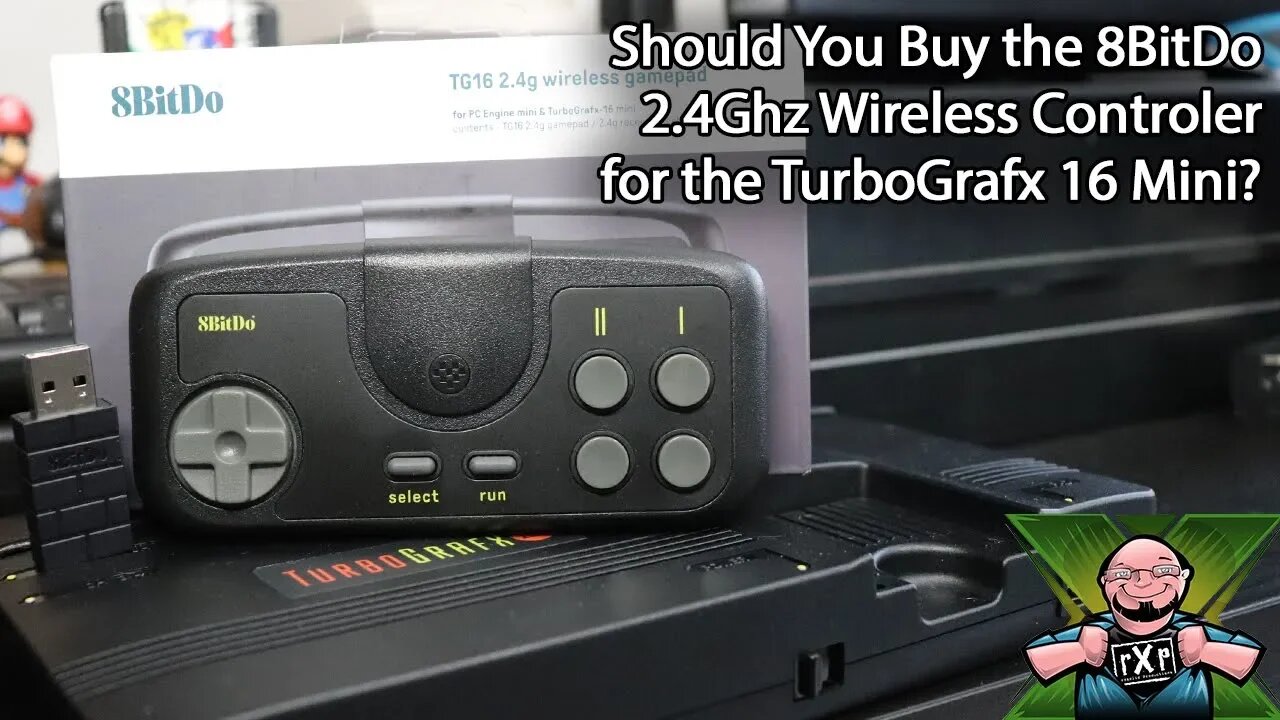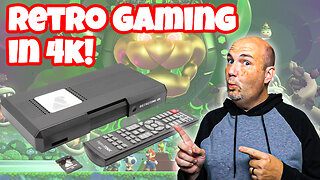Premium Only Content

Should You Buy the 8BitDo TG16 2.4Ghz Wireless Controller for the Turbo; Grafx 16 Mini?
In this video, we unbox and test out the 8BitDo 2.4GHz Wireless controller for the TurboGrafx 16 Mini.
8BitDo has been making wireless controllers for a long time. One of the original reviews I produced for the channel was about the 8BitDo wireless controller for the NES Classic Edition, and since then I've checked out a ton of their products. When I heard that 8BitDo was creating not one, but three, wireless controllers for the TurboGrafx Mini, I wanted to check it out.
When I mention there are 3 variants of their wireless controller, there's one each patterned after the TurboGrafx 16 controller (shown here), one after the Core Grafx, and one after the PC Engine. Each one takes design cues from the original model's controller, but each one also has their own unique take. One of the biggest is the replacement of the Turbo Slide Switches with turbo buttons. Instead of using the same button for single fire or rapid fire you have a dedicated turbo button. The advantage of this is you can use turbo when you want OR use a single button press when you want, and you don't need to deactivate the turbo function.
As cool as the turbo button is, it seemlingly lacks the original's adjustable fire rate. While it is not covered in the manual, you CAN actually change the rate of rapid fire on the controller itself. Simply hold down the Select, II, & I buttons at the same time for 5-seconds to adjust the turbo speed. I don't know why this wasn't in the manual, but it's a pretty big miss by 8BitDo.
The shape and size of the controller is a little different than the originals. It is a bit smaller than the OG controller, but the back also has a different shape and profile than the originals. I don't know that I like this change, as the original is really comfortable and I like the humps on the back. While the overall size is smaller, the D-Pad and buttons feel pretty similar and are quite responsive.
But how does it play games? First of all, like most 8BitDo controllers, it's pretty darned responsive. I didn't feel like I was feeling any sort of lag or delay while playing. Battery life is really good, but I will say I wish the charge port was a USB-C connector instead of Micro USB. The range is listed to be 30-feet, and while I never went that far I never ran into any range issues. Finally, for convenience, the controller was pre-paired to the dongle.
Why it RoX:
- 3 Styles to match or complement your system
- Turbo functionality
- Under $30
- Decent responsiveness
- Good build quality
- Also works with Nintendo Switch
What could be improved?
- Instructions don't tell you how to change turbo speed
- No visual indication of actual turbo setting
- Change in ergonomics may not suit all
- Micro USB charge port instead of USB-C
- Power button should be labeled
- 8BitDo has never once responded to any communication, so I have little faith that, if I have an issue, I'll be able to get help
Should You Buy One?
If you absolutely want to have to go wireless with your TurboGrafx 16 Mini, at this time, this is about the only way to go. That means by default it is the best way to go if you want to go wireless. That being said, I don't feel that this is superior to the original USB controllers at all, except for being wireless. If I take my TG16 Mini into my living room to play, I'll use this as I'd sit further than 10-feet from the console to play. Beyond that, I'll stick with the stock controller myself. I think it is more comfortable, and I also prefer the slide-switch setup for turbo vs the dual button setup.
#8BitDo #TurboGrafx #Review
The footage used in this review are used under the Fair Use laws, referenced below:
https://www.law.cornell.edu/uscode/text/17/107
Notwithstanding the provisions of sections 106 and 106A, the fair use of a copyrighted work, including such use by reproduction in copies or phonorecords or by any other means specified by that section, for purposes such as criticism, comment, news reporting, teaching (including multiple copies for classroom use), scholarship, or research, is not an infringement of copyright. In determining whether the use made of a work in any particular case is a fair use the factors to be considered shall include—
(1) the purpose and character of the use, including whether such use is of a commercial nature or is for nonprofit educational purposes;
(2) the nature of the copyrighted work;
(3) the amount and substantiality of the portion used in relation to the copyrighted work as a whole; and
(4) the effect of the use upon the potential market for or value of the copyrighted work.
The fact that a work is unpublished shall not itself bar a finding of fair use if such finding is made upon consideration of all the above factors.
(Pub. L. 94–553, title I, § 101, Oct. 19, 1976, 90 Stat. 2546; Pub. L. 101–650, title VI, § 607, Dec. 1, 1990, 104 Stat. 5132; Pub. L. 102–492, Oct. 24, 1992, 106 Stat. 3145.)
-
 53:35
53:35
RoXolidProductions
7 months ago $0.01 earnedThe Ultimate Retro Gaming Upgrade | RetroTink 4K Review
2642 -
 1:47:09
1:47:09
Fresh and Fit
6 hours agoMoney Monday Call-In Show
53.2K9 -
 1:48:50
1:48:50
Glenn Greenwald
7 hours agoDC Attacks Trump's Most Disruptive Picks; Biden Authorizes Massive Escalation With Russia; Joe & Mika Meet With "Hitler" | SYSTEM UPDATE #367
105K127 -
 1:44:34
1:44:34
Tucker Carlson
6 hours agoTucker Carlson and Russ Vought Break Down DOGE and All of Trump’s Cabinet Picks So Far
152K216 -
 1:42:47
1:42:47
Flyover Conservatives
23 hours agoBO POLNY | The Best and Worst Times Are Coming – Are You Ready? | FOC Show
26.1K10 -
 51:12
51:12
BIG NEM
9 hours agoWelcome to Our Uncensored Show: Trump, Simulation Theory & the Albanian Mob - EP1
40.5K11 -
 2:05:14
2:05:14
Robert Gouveia
8 hours agoFBI Criminals Get LAWYERS; STOP Counting ILLEGAL Votes; Time to Disbar Tish James
58.5K95 -
 1:00:30
1:00:30
The StoneZONE with Roger Stone
6 hours agoAre We Heading For World War III? General Michael Flynn Joins The StoneZONE w/ Roger Stone
40.4K11 -
 1:14:12
1:14:12
We Like Shooting
16 hours ago $1.03 earnedDouble Tap 384 (Gun Podcast)
18.5K -
 4:17:21
4:17:21
Tundra Gaming Live
8 hours ago $2.11 earnedThe Worlds Okayest War Thunder Stream
31.2K2